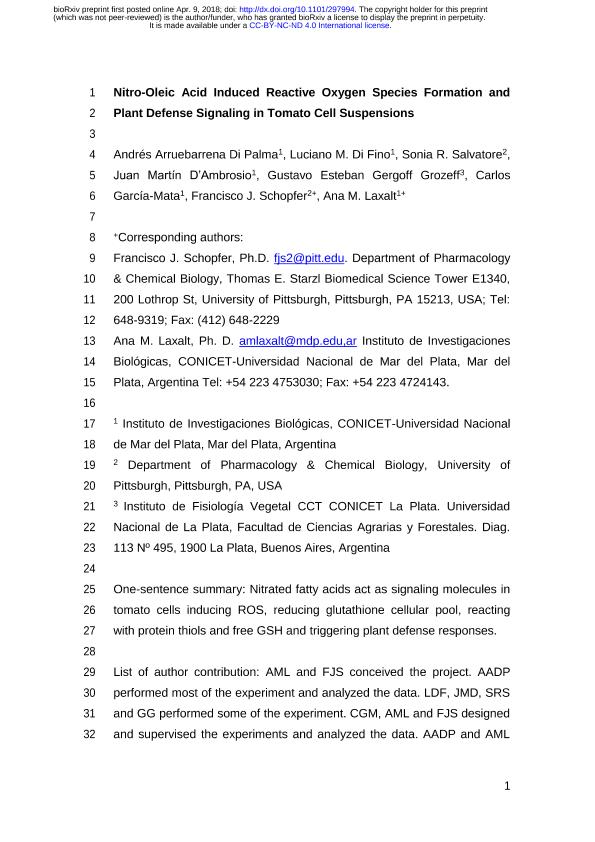Artículo
Nitro-Oleic Acid Induced Reactive Oxygen Species Formation and Plant Defense Signaling in Tomato Cell Suspensions
Arruebarrena Di Palma, Andrés ; Di Fino, Luciano Martin
; Di Fino, Luciano Martin ; Salvatore, Sonia Rosana; D'ambrosio, Juan Martín
; Salvatore, Sonia Rosana; D'ambrosio, Juan Martín ; Gergoff Grozeff, Gustavo Esteban
; Gergoff Grozeff, Gustavo Esteban ; Garcia-Mata, Carlos
; Garcia-Mata, Carlos ; Schopfer, Francisco Jose; Laxalt, Ana Maria
; Schopfer, Francisco Jose; Laxalt, Ana Maria
 ; Di Fino, Luciano Martin
; Di Fino, Luciano Martin ; Salvatore, Sonia Rosana; D'ambrosio, Juan Martín
; Salvatore, Sonia Rosana; D'ambrosio, Juan Martín ; Gergoff Grozeff, Gustavo Esteban
; Gergoff Grozeff, Gustavo Esteban ; Garcia-Mata, Carlos
; Garcia-Mata, Carlos ; Schopfer, Francisco Jose; Laxalt, Ana Maria
; Schopfer, Francisco Jose; Laxalt, Ana Maria
Fecha de publicación:
04/2018
Editorial:
Cold Spring Harbor Laboratory Press
Revista:
bioRxiv
ISSN:
2692-8205
Idioma:
Inglés
Tipo de recurso:
Artículo publicado
Clasificación temática:
Resumen
Nitrated fatty acids (NO2-FAs) are formed by the addition reaction of nitric oxide- and nitrite-derived nitrogen dioxide with unsaturated fatty acids. Nitrated fatty acids act as signaling molecules in mammals through the formation of covalent adducts with cellular thiols. The study of NO2-FAs in plant systems constitutes an interesting and emerging area. The presence of NO2-FA has been reported in olives, peas, rice and in Arabidopsis. To gain a better understanding of the role of NO2-FA on plant physiology, we analyzed the effects of exogenous application of nitro-oleic acid (NO2-OA) to tomato cell cultures. We found that NO2-OA induced reactive oxygen species (ROS) production in a dose-dependent manner via activation of NADPH oxidases, which requires calcium entry from the extracellular compartment and protein kinase activation, a mechanism that resembles the plant defense responses. NO2-OA-induced ROS production, expression of plant defense genes and led to cell death. The mechanism of action of NO2-OA involves a reduction in the glutathione cellular pool and covalently addition reactions with protein thiols and reduced glutathione. Altogether, these results indicate that NO2-OA triggers responses associated with plant defense, revealing its possible role as a signal molecule in biotic stress.
Archivos asociados
Licencia
Identificadores
Colecciones
Articulos(IIB)
Articulos de INSTITUTO DE INVESTIGACIONES BIOLOGICAS
Articulos de INSTITUTO DE INVESTIGACIONES BIOLOGICAS
Articulos(INFIVE)
Articulos de INST.DE FISIOLOGIA VEGETAL
Articulos de INST.DE FISIOLOGIA VEGETAL
Citación
Arruebarrena Di Palma, Andrés; Di Fino, Luciano Martin; Salvatore, Sonia Rosana; D'ambrosio, Juan Martín; Gergoff Grozeff, Gustavo Esteban; et al.; Nitro-Oleic Acid Induced Reactive Oxygen Species Formation and Plant Defense Signaling in Tomato Cell Suspensions; Cold Spring Harbor Laboratory Press; bioRxiv; 4-2018; 1-24
Compartir
Altmétricas



